Events
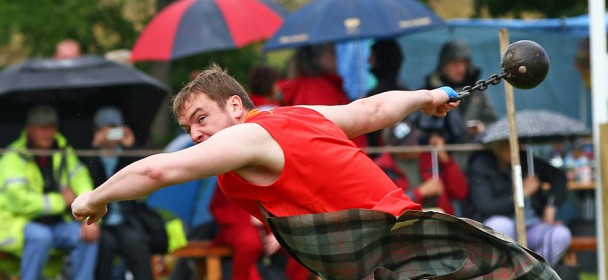
The 2016 World Highland Games Invitational Heavy Events Championships will have a total of 8 throwing events throughout the afternoon. They are;
- 16lb ball
- 22lb stone
- 16lb Scots hammer
- 22lb Scots hammer
- 56lb weight for distance
- 28lb weight for distance
- 56lb weight for height
- Tossing the caber
The first event starts at 11am and the prize ceremony should be at around 5pm.
After the Championships prize ceremony and towards the end of the afternoon, there will be a special challenge event: Tossing the 16lb sheaf. This event is sponsored by The Caithness Collection – comprising of The Norseman Hotel, Wick, The Pentland Hotel, Thurso & The Castletown Hotel, Castletown by Thurso.
This event is quite rare at a Highland Games in Scotland. The sheaf is expected to be tossed over a bar at least 30 foot (9m) in height and is quite a spectacle.
There will also be a Farmer’s Walk strongman event at around 4pm. This comprises of lifting the two Gerston stones (one in each hand) and walking as far as one can before they drop to the ground.
Heavyweight athletes must wear the kilt when competing, but any other attire is allowed.
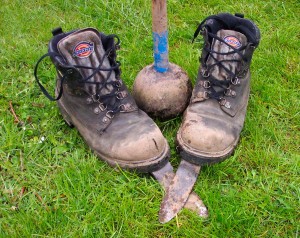 Scots Hammer
Scots Hammer
The ScotsHammer has a shaft made of flexible cane and a round metal ball of 16lb or 22lb. The throwers have special boots with metal spikes protruding from the toe. They dig these into the ground before each throw as this gives them more stability and pitch when they swing the hammer around their head to generate angular speed. The thrower has their back to the throwing area and the hammer is released over their shoulder after 3 or 4 swings. Their feet cannot move prior to release and they must stay behind the wooden “trig” (toeboard) throughout the t
hrow. The athletes apply a sticky resin to their hands for extra grip. Most produce their own resins to a secret recipe, with violin wax being a main ingredient.
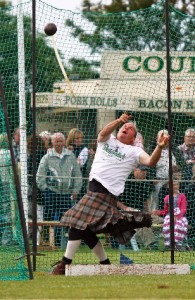 Each competitor has a maximum of three throws, but an extra throw is offered to the winner to allow an opportunity to break ground or world records. Sometimes throws are reduced to two attempts if there are too many athletes and when finishing on time is a factor. A safety net is essential for this event as the hammers travel great distances (over 150 feet) and can cause serious injury.
Each competitor has a maximum of three throws, but an extra throw is offered to the winner to allow an opportunity to break ground or world records. Sometimes throws are reduced to two attempts if there are too many athletes and when finishing on time is a factor. A safety net is essential for this event as the hammers travel great distances (over 150 feet) and can cause serious injury.
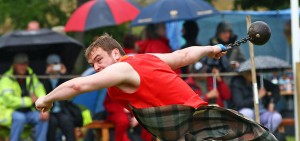 Weight for Distance
Weight for Distance
The “Weight for Distance” is an event where the weights are of metal with a small chain and ring handle attached for the 28lb weight and just a ring for the 56lb weight. The weight is thrown one-handed from behind a wooden “trig” with a 9 foot run-up allowed. Any style may be used, but the most ef
ficient is to spin like a discus thrower. Touching the top of the trig or any other part of the ground beyond the trig is a foul, whether the weight has been thrown or not. This event is regarded as the most graceful and even though it may look easy, it is a very technical and difficult event. Each competitor has a maximum of three throws, but an extra throw is offered to the winner to allow an opportunity to break ground or world records.
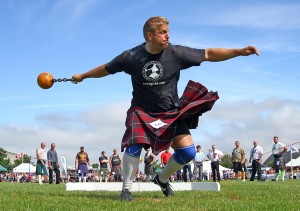 Weight for Height
Weight for Height
The “Weight for Height” event uses a block or ball weight of 56lb to which a ring handle is attached. The objective is to throw the weight up and over a bar similar to that used in pole vaulting. The competitor is only allowed to use one hand. Most use a standing still technique by swinging the weight between their legs to generate speed prior to release. Some use a spinning technique to generate more speed. The trick is not just to gain height, but to get the weight to arc over the bar without landing on their head!
Competitors may pass until the bar reaches the height where they wish to enter the competition. Once they start to throw, they must compete each time the bar is raised. Each competitor is allowed three attempts to clear the bar at each height. If the weight touches the bar on its way over, but does not dislodge the bar, it is considered a successful throw. If two or more competitors fail at the same height, then the one with fewer misses at the previous height is considered the winner.
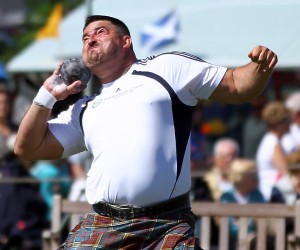 Shot Putt
Shot Putt
The shot putt is the same as the Olympic shot putt, except there is no smooth concrete throwing area, just rough grass! The metal ball is delivered from behind a 6″ high x 4′-6″ long “trig” and must be putted from in front of the shoulder using one hand only. The throwing area allows a 7′-6″ run-up and each competitor is allowed three attempts. Any technique is allowed, with some using a glide technique and others a spinning one.
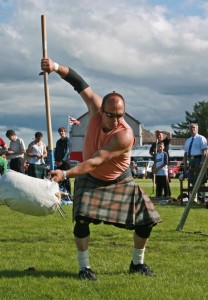 Tossing the Sheaf
Tossing the Sheaf
The sheaf toss event is quite rare for a Games in Scotland, with only a handful staging it, but it is popular in the USA and Canada. It is a great spectator event as heights of ove
r 30 feet are achieved. A two pronged fork is used to throw a 16lb bag of grass over a bar. Athletes stand with their back to the bar and then spear the bag with the pitchfork. The pitchfork and sheaf is swung from side to side before a final fast swing sees the sheaf launched into the air. Some athletes use a spinning technique to generate more speed before throwing the sheaf. There are 3 throws allowed at each height. There is no recognised ground record as it is difficult to standardise the sheaf for weight, shape and size. When it rains the sheaf becomes heavier! Heights of 34 feet have been seen at Halkirk and the world record is around 40 feet.
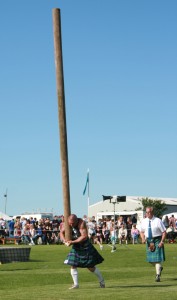 Tossing the Caber
Tossing the Caber
The term “caber” derives from the Gaelic word “cabar” or “kaber” which refers to a wooden beam. Caber tossing is said to have developed from the need to toss logs across narrow chasms, in order to cross them, or into rivers to float them to a transport pick up point.
Tossing the caber is the signature event for Highland Games in general. It is totally unique in sport and is the ultimate event for speed, strength and skill needed by a Scottish Heavyweight athlete. There is no standard size or weight for a caber. Each games has its own unique one. Some are rough tree trunks, but most like Halkirk, are smooth wooden telegraph poles. The length can vary from 15 feet to 21 feet and the weight from 100lbs to 200lbs. Halkirk has two cabers, one is 19 feet long and 150lbs, the other is 18 feet long and 125lbs.
The end where the athlete picks up the caber, is thinner than the top end and is rounded in shape to make it easier to grasp and release. The top end that is in the air, has a straight cut edge so that it digs into the ground when tossed and makes it more likely to grip and topple over rather than skid away. The aim is not to throw the caber the furthest, but to throw it the straightest after being flipped end over end. Athletes run as fast as they can before coming to a sudden stop. This makes the caber swing forward due to its own momentum and the athlete has to time it just right to heave upwards and make it flip over.
The judge runs behind the athlete as he makes his run with the caber grasped tight into his shoulder. There is no set position or “trig” to stay behind in making the toss. The athlete can run as far as he wants. The judge uses an imaginary clock face to decide who is the winner. A perfect toss is one where the caber lands in a perfect straight line and said to be a 12 O’Clock throw. Cabers that are not thrown perfectly are given scores such as 2 minutes past twelve or one O’Clock etc. There is also another judge standing to the side of the throwing area who estimates the angle the caber reaches if it does not turn over. The higher the angle the better. Each athlete has three attempts and only the very best can successfully toss cabers.


















